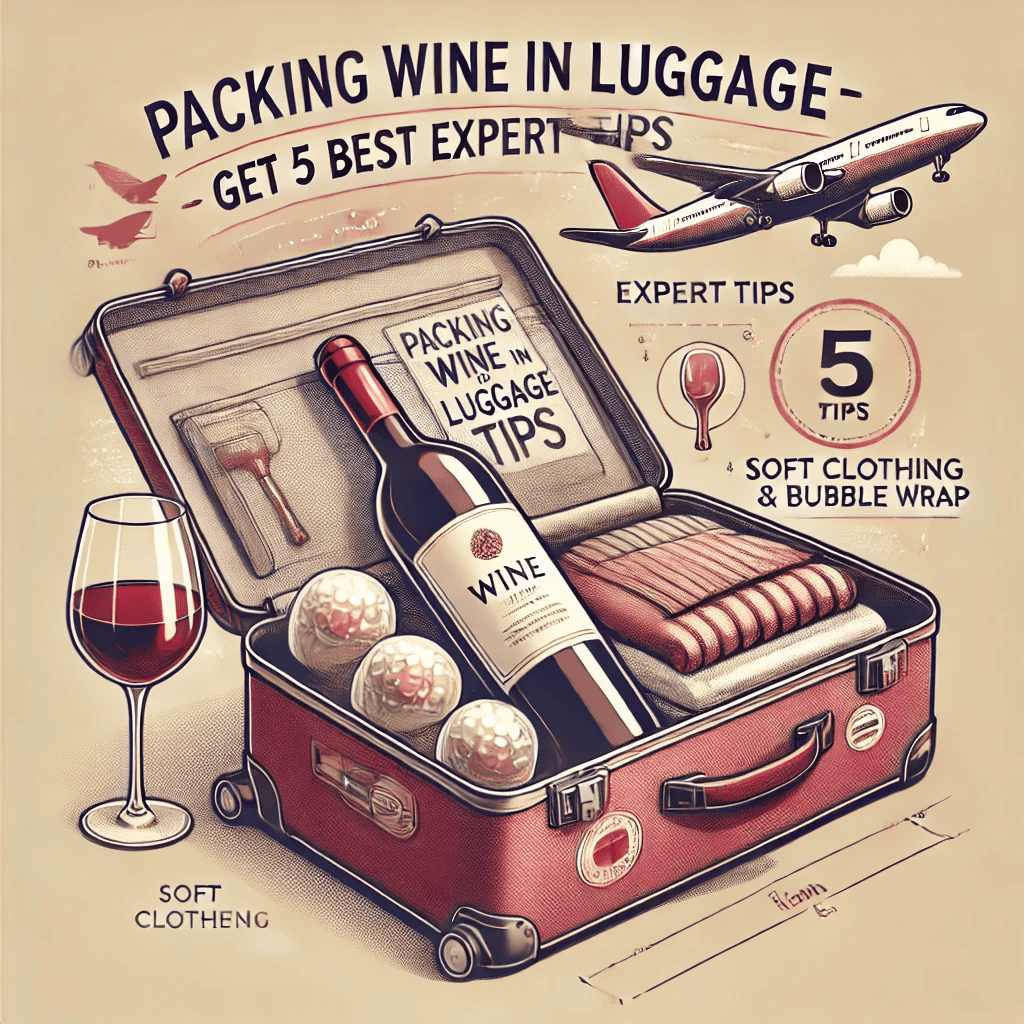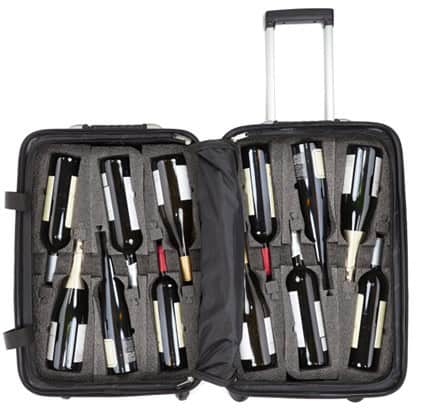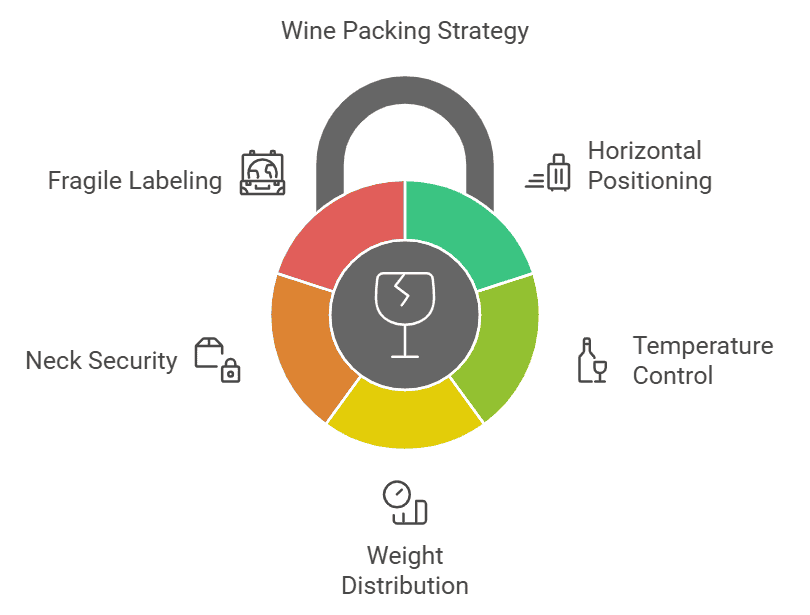Did you know that approximately 87% of wine bottles broken during air travel are due to improper packing techniques? As a wine enthusiast who’s traveled across 20+ wine regions, I’ve learned the hard way that transporting your precious vintages requires more than just wrapping them in clothes and hoping for the best!
Whether you’re bringing back a special bottle from your Tuscan vacation or planning to gift a rare vintage to friends abroad, knowing how to properly packing wine in luggage can mean the difference between celebrating with a glass of Bordeaux and cleaning up a soggy, glass-filled mess.
Let’s dive right into and get the latest tips and hints on protecting your precious bottles best while traveling.
Welcome to Didi Somm and Cheers!
Important Notice: The information in this article is for general and public information purposes only. It solely reflects Didi Somm’s or his Staff’s opinion, and no responsibility can be assumed for errors or omissions in the service’s contents. For details, please check the Disclaimer at the bottom of the homepage.

Key Takeaways
- Always pack wine in checked luggage, never carry-on
- Use specialized wine bottle protectors or proper cushioning materials
- Check airline regulations and customs requirements beforehand
- Maximum alcohol content allowed is typically 70% ABV
- Limit: Usually up to 5L of wine (around 6 bottles) per person
- Temperature fluctuations can affect wine quality during transport
Understanding Airline Regulations for Transporting Wine
Let me tell you, navigating airline regulations for wine transport used to make my head spin! After countless trips bringing back treasures from wine regions, I’ve become something of an expert on this stuff. Here’s what you really need to know about getting your precious bottles home safely and legally.
First things first: TSA allows wine in checked baggage, but there’s a catch – the alcohol content has to be under 70% (140 proof). Thankfully, most wines fall way below this at 11-14% ABV, so we’re good there! I learned this the hard way when I tried bringing some fortified port through customs without checking the rules first.
When it comes to quantity limits, most airlines allow up to 5 liters per passenger in checked bags. Pro tip: I always pack a printout of the airline’s specific policy – saved my behind more than once when dealing with confused check-in staff! Trust me on this one.
International flights get a bit trickier. You’ll need to declare your wine at customs, and different countries have varying limits on how much you can bring in duty-free. I keep a digital folder of customs forms on my phone now, after nearly losing some amazing Bordeaux to confiscation in 2019.
Here’s something most folks don’t know: some airlines like Emirates and Singapore Airlines actually provide special wine packaging services if you ask at check-in. Totally worth investigating before your flight! I’ve found airline policies can vary dramatically – Delta tends to be pretty chill about wine transport, while budget carriers often have stricter rules.
Make sure you’ve got documentation showing where and when you purchased the wine. Customs officers love paperwork, and having those receipts handy has helped me breeze through more times than I can count.

Essential Packing Materials for Safe Wine Transport
Okay, listen up – after breaking two bottles of premium Burgundy in my luggage (still hurts to think about!), I’ve become borderline obsessive about proper packing materials. Let me share what actually works, based on some pretty expensive trial and error.
WineSkin Bags
The absolute game-changer for me has been WineSkin bags. These sealed, padded bags have saved countless bottles during turbulent flights. They’re not cheap at around $5-7 each, but way cheaper than losing that special bottle you’ve been dreaming about getting home.

Hard-Shell Wine Suitcase
For serious wine travelers, invest in a VinGardeValise or similar hard-shell wine suitcase. Yeah, they’re pricey (mine was about $400), but mine has protected dozens of bottles across thousands of miles. The foam inserts are specifically molded for wine bottles, and I’ve never had a break.

Alternative Packing Materials & DIY Hack
Don’t have specialized gear? No worries – I’ve MacGyvered some pretty effective solutions. Thick socks work surprisingly well as bottle sleeves! Pool noodles cut to size make fantastic protective tubes, and bubble wrap from Amazon packages can be repurposed for extra cushioning.
Inflatable wine protectors are my new favorite discovery. They’re lightweight when empty and provide seriously good protection. I actually tested one by (carefully!) dropping it from waist height – bottle survived without a scratch!
One DIY hack I’m particularly proud of: using those cardboard drink carriers from coffee shops, reinforced with bubble wrap. They’re free, recyclable, and actually work pretty well for shorter trips. Just make sure to double-wrap each bottle section.
The Do’s of Packing Wine in Luggage
You wouldn’t believe how much I’ve learned about proper wine packing through sheer trial and error! After countless flights (and yes, a few heartbreaking losses), I’ve developed a foolproof system that hasn’t failed me yet.
Position those bottles like you’re handling newborn babies – they need to lie horizontally, never standing up! I arrange them perpendicular to the wheel direction of my suitcase, which minimizes movement during those rough baggage handler moments. Each bottle should be surrounded by at least 2 inches of cushioning material.
Temperature is crucial, folks! I always wrap my bottles in clothing – merino wool works great for insulation. The cargo hold gets seriously cold, which isn’t great for wine. I’ve found that creating a cocoon of clothes around the wine section helps maintain a more stable temperature.
Here’s a game-changing tip: distribute the weight evenly! I place bottles in the center of the suitcase, then build outward with clothes and other items. This creates a protective barrier and prevents the dreaded suitcase topple. I learned this after a particularly nerve-wracking experience when my bag kept falling over in the security line!
Always, always secure those bottle necks extra well – they’re the most vulnerable part. I use small bubble-wrap rolls specifically around the necks, secured with tape. And don’t forget to slap those “FRAGILE” stickers all over your luggage – I’ve noticed baggage handlers actually do pay attention to them.

The Don’ts of Packing Wine in Luggage
Let me share some hard-learned lessons about what NOT to do when packing wine – mistakes that have cost me some pretty special bottles over the years. Trust me, these are face-palm moments you’ll want to avoid!
Never, ever pack bottles directly against the suitcase walls! I made this rookie mistake early on, and let’s just say that beautiful Barolo never made it home. The suitcase edges take the most impact during handling, so keep at least 3 inches of buffer space there.
Watch those temperature danger zones like a hawk. I once left my packed suitcase in a hot car for a few hours before a flight – big mistake! The heat expanded the wine, putting pressure on the corks. Two bottles leaked, and my clothes looked like I’d murdered somebody. Now I keep my packed wine cool until the last possible moment.
Here’s a mistake I see people make all the time: using paper or thin cardboard as the only protection. Might as well just break the bottles yourself and save the airline the trouble! And please don’t rely on those flimsy plastic shopping bags – they’re absolutely useless for protection.
The biggest no-no? Packing different sized bottles right next to each other. The varying heights create pressure points that can spell disaster. I learned this the expensive way when a magnum cracked a standard bottle during a particularly bumpy flight.
Weight distribution is crucial – don’t stack bottles on top of each other! I once thought I was clever by laying them in layers. The pressure from the top bottles actually cracked the ones below during handling. Stick to a single layer, always.

Professional Tips for Special Wine Types
After years of transporting everything from vintage champagne to massive magnums, I’ve picked up some specialized knowledge about handling different wine types. Each one needs its own special attention – trust me, I’ve learned these lessons the hard way!
Sparkling Wines
Sparkling wines require extra TLC, folks. The pressure inside those bottles makes them more susceptible to temperature changes. I always double-wrap my champagne and wrap it in clothing for temperature stability. Lost a bottle of Dom Pérignon once before figuring this out – still hurts to think about it!
Vintage Wines
For those precious aged wines, stability is absolutely crucial. I’ve found that keeping them as still as possible during transport helps prevent disturbing any sediment. My secret weapon? Those foam corner protectors used for shipping furniture – they’re perfect for keeping bottles from shifting.
Natural Wines
Natural wines need extra attention because they’re often more delicate. I learned this after a particularly sad incident with an unfiltered orange wine. Now I always pack them in the center of my suitcase, surrounded by the most padding, and keep them extra cool.
Here’s something interesting about screw caps versus corks: contrary to what you might think, screw cap bottles can actually be more vulnerable to pressure changes! I always ensure the caps are super tight and wrap the neck area with extra padding.
Large Format Bottles
Large format bottles? They’re a whole different ballgame! I’ve developed a special technique using pool noodles cut lengthwise as a cradle, then reinforced with bubble wrap. Works like a charm for those unwieldy magnums and double magnums.
Insurance and Liability Considerations
Let’s talk about protecting your investment, because boy, have I learned some expensive lessons about wine transport insurance! After losing an irreplaceable bottle from a small French producer, I dove deep into the world of wine shipping insurance.
Most regular travel insurance won’t cover wine damage – found that out the hard way! You’ll want to look specifically for policies that cover “fragile items” or “collectibles.” I now use a specialized coverage that costs about $15 per $500 of wine value. Totally worth the peace of mind!
Here’s something crucial about airline liability: most carriers limit their responsibility for damaged checked bags to around $3,500 for international flights. But here’s the kicker – they often exclude “fragile items” unless they’re packed in original shipping containers. I always take photos of my packing process now, just in case.
Value declaration is super important at check-in. I made the mistake of not declaring higher-value wines once, and the airline wouldn’t even consider my claim when things went south. Now I always declare anything worth over $100 per bottle.
Document everything! I keep a detailed inventory with photos, purchase receipts, and packing evidence. When I had to file a claim last year, this documentation made the difference between approval and denial. I even take pictures of the luggage before checking it now.
Prevention really is your best insurance policy. I’ve found that spending extra on quality packing materials has saved me more money in the long run than any insurance claim could cover. Plus, most policies have such high deductibles that avoiding damage altogether is always the better option.
Our Tip: Please check the following specialized US Wine Insurers, InsureMyWine or HORTEN, for details and a quotation.
FAQ – Packing Wine in Luggage
- Q: Can I pack wine in my carry-on luggage? A: No, TSA regulations prohibit liquids over 3.4 oz (100ml) in carry-on luggage. Wine must be packed in checked baggage.
- Q: How many bottles of wine can I pack in my luggage? A: Typically, you can transport up to 5L of wine (about 6-7 bottles) per person in checked luggage, but this varies by airline and country.
- Q: Do I need to declare wine at customs? A: Yes, you must declare wine at customs. Some countries have specific limits and may charge duty fees.
- Q: What’s the best way to protect wine bottles in luggage? A: Use specialized wine bottle protectors, bubble wrap, or wine skin bags, and place them in the center of your luggage surrounded by soft clothing.
- Q: Can wine bottles explode in luggage due to pressure? A: While rare, pressure changes can affect wine bottles. Using proper protection and ensuring bottles are properly sealed reduces this risk.
- Q: Should I wrap wine bottles in clothing? A: While clothing can provide additional cushioning, it shouldn’t be the primary protection method. Use specialized protection first.
- Q: What’s the best position to pack wine bottles? A: Pack bottles lying horizontally with the cork facing sideways to keep it moist and prevent leakage.
- Q: Can I pack sparkling wine in my luggage? A: Yes, but extra precautions are needed due to pressure. Use specialized champagne bottle protectors.
- Q: What documentation do I need for transporting wine? A: Carry purchase receipts and check customs regulations for both departure and arrival countries.
- Q: How can I protect wine from temperature changes during travel? A: Use insulated wine protectors and pack bottles in the center of your luggage surrounded by clothing.
- Q: What’s the maximum alcohol percentage allowed in luggage? A: Most airlines allow up to 70% ABV in checked luggage, but wine typically falls well below this limit.
- Q: Should I notify the airline about wine in my luggage? A: While not required, marking your luggage as fragile and informing check-in staff can ensure careful handling.
- Q: What happens if my wine bottles break during transit? A: Check your travel insurance policy and airline liability coverage. Keep all documentation for potential claims.
- Q: Can I ship wine separately instead of packing it? A: Yes, but shipping wine internationally requires specific permits and may be more expensive than traveling with it.
- Q: How do I clean my luggage if a bottle breaks? A: Use wine skin bags or protective sleeves to contain potential leaks. If breakage occurs, professional cleaning may be required.
Conclusion
Successfully transporting wine in your luggage comes down to smart planning and careful execution. After years of experience, I’ve learned that following a few essential guidelines ensures your precious bottles arrive safely at their destination.
Remember these key points: always pack wine in checked luggage, stay within the 5L per person limit, and keep proper documentation handy. Invest in quality protection materials – whether specialized wine skin bags or careful DIY solutions with bubble wrap. Position bottles horizontally in your luggage’s center, surrounded by protective layers.
Consider temperature management by booking direct flights when possible, and always research airline policies and customs regulations before traveling. Mark your luggage as fragile and document your packed wines with photos for insurance purposes.
While it requires extra effort, the joy of sharing that special bottle from your travels makes it all worthwhile. Remember – the best bottle of wine is the one that arrives unbroken!
For your reference, the latest articles by Didi Somm include:
- Expert Guide to Portable Wine Storage: All You Need to Know
- 10 Best Tips For Transporting Wine Safely: Your Expert Guide
- Best Wine Temperature During Transport – All You Need To Know
- Wine Vibration During Transport: Get 7 Expert Tips and More
- Best Portable Wine Coolers – Get Our Expert Tips Here
- How to Choose the Perfect Wine Travel Case – 8 Tips for Your Next Adventure
Important Notice: The information in this article is for general and public information purposes only. It solely reflects Didi Somm’s or his Staff’s opinion, and no responsibility can be assumed for errors or omissions in the service’s contents. For details, please check the Disclaimer at the bottom of the homepage.

